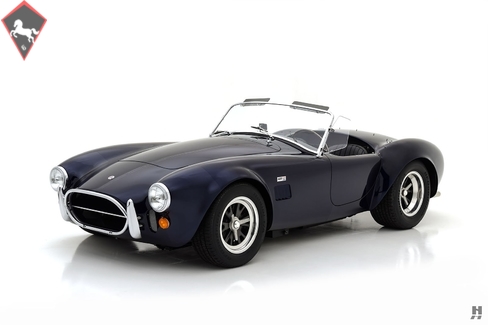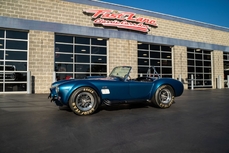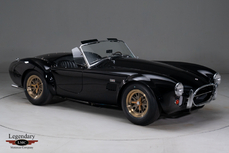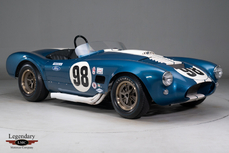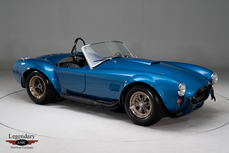Shelby Cobra 427 Cobra Roadster 1967
Allgemeine Beschreibung :
From day one, racing played a vital role in the Shelby Cobra’s development. The small-block Shelby Cobra (AC Cobra in the UK) was an instant sensation on the street and the race track, with the agile little roadsters handily showing the new Corvette Stingray a clean pair of heels in SCCA competition. By the mid-1960s, Shelby was racing the Cobra roadster and special-bodied Daytona Coupe on the world stage, taking on the might of Ferrari in the GT class and coming out on top for the 1965 season. All along, however, the quest for more power weighed heavily on the minds of Carroll Shelby and his right-hand man, Ken Miles. By 1963/1964, the 289 was at the peak of its development, maxing out at 385 reliable horsepower and stay at the sharp end of the field, they knew the Cobra needed a lot more grunt.
Following an uncharacteristic embarrassment at the hands of the Grand Sport Corvettes during the 1963 Nassau Speed Week, Ken Miles retreated to the drawing board. A past drive in a 427-powered NASCAR Galaxie left a deep impression on Miles, and he felt the big-block would be the perfect fit for the lightweight Cobra. A hastily built prototype using 289 suspension was tested at Sebring, and despite woeful handling, it proved to be blisteringly fast in a straight line. Its performance was enough to convince Shelby, Miles, and Ford that the 427 would power the next generation Cobra. A great deal of development followed as the Cobra chassis was wholly reworked to handle the additional weight and power of the big Ford V8. Ford offered the services of its chassis engineers to assist Miles, with the only restriction being the 90-inch wheelbase which formed the basis for all of AC’s body jigs. Chassis tube diameter increased to 4-inches, and the antiquated leaf-spring arrangement tossed out in favor of an all-new fully adjustable coil-spring setup at all four corners. The body was heavily reworked with dramatic flared wheel arches to accommodate the fat rubber required to put the power to the ground. With the new chassis, the 427 Cobra delivered handling that rivaled the small block 289, coupled with astonishing straight-line performance. For decades to come, few cars could touch the 427 Cobra for its near-mythical performance. Even today, the 427 Cobra counts among the greatest sports cars ever built, and they enjoy permanent standing as true automotive icons.
Our featured Cobra is CSX 3341, one of only 343 genuine coil-spring, big-block Cobras produced. A very late production example, this car is among the last 20 cars built by Shelby, and it presents in stunning condition, with a recently-completed restoration by noted Cobra expert Mike McCluskey. The history of this particular chassis is well-documented by the Shelby American Automobile Club. It was sold new to Richard Darnell of South Bend, Indiana by Romy Hammes Ford (also of South Bend) in July of 1967. SAAC registry information lists the original color as Rangoon Red over a black interior, and equipped with a 427 engine with dual-quad intake. After just one year and 1900 miles, Darnell listed the car for sale. A series of owners followed, with documents noting its appearance at the 2nd annual SAAC convention held in Hershey, Pennsylvania in 1977. There, it was recorded to show 30,000 miles, fitted with sunburst wheels, under-car exhaust exiting ahead of the rear wheels, and dark jade green paintwork. By the mid-1980s, it reappeared finished in Rangoon Red and with a correct-type replacement 427 engine built by noted Ford guru Jack Roush. In the early 1990s, it had passed through the hands of Mike McCluskey for the first time, where it received several updates including side exhaust, S/C wheel arch lips, and a hood scoop. Eric Bernhard of Entropy Racing installed a factory style 3-point roll bar and updated the suspension and brakes for vintage racing. At that point, the car was repainted in Viking Blue with white stripes. In this configuration, the car raced extensively on the West Coast, appearing multiple times at the Monterey Historics and the Wine Country Classic at Sonoma Raceway throughout the 1990s and early 2000s.
The current owner acquired the car from Gary Hunter in approximately 2011. In 2016 he commissioned Mike McCluskey to perform a complete, concours quality restoration and return the car to street specification. Still appearing very fresh, CSX 3341 is an absolutely exquisite example. Mr. McCluskey noted that while some minor chassis tubes were replaced over time, neither body nor chassis showed evidence of crash damage or severe corrosion. His team took great care to preserve the originality while returning the car to its factory street spec. It now presents in absolutely gorgeous condition, with correct under-car exhaust, proper street-spec wide-hip wheel arches, and no roll bar. The dark midnight blue paintwork and unadorned street trim accentuate the beautiful lines, and the quality of the finish is outstanding, with impeccable panel fit and detailing. Like the exterior bodywork, the inner panels are restored to exacting standards, with new foot boxes, inner trunk panels, and fender wells all appearing correct and beautifully finished. The process of the restoration is well-documented in a series of photographs.
Purposeful and straightforward, the two-seat cockpit is all about the business of handling the mighty 427 with no distractions. Once aboard, the seats are quite comfortable, and the controls fall easily to hand. The soft trim consists of period-correct leather, vinyl, and carpet, all in black as original. Smiths instruments are fully restored, and the wheel and shift lever are proper 427 items. Like the body, the interior restoration is impeccably detailed and executed to a very high standard.
Under the bonnet sits the heart and soul of the Cobra legend – Ford’s mighty 427 cubic inch V8. Like the rest of the car, the engine is highly detailed, with an authentic presentation. As part of the restoration, the engine was stripped down, sonic checked, and completely rebuilt with a balanced rotating assembly. Fed by a single 4-bbl carburetor, it runs strong and delivers the kind of breathtaking performance one expects from a big-block Cobra. Information from both the restorer and The Cobra Registry points to CSX 3341 being a cherished car for its entire life. Evidence shows it was never wrecked, neglected or cut up, and the few modifications it did receive to go racing were done so without sacrificing the car’s highly original character. Now fresh from a world-class restoration and equally suited to concours and road events, CSX 3341 will surely impress the most discerning enthusiast.
https://hymanltd.com/vehicles/6423
1967 Shelby Cobra 427 Cobra Roadster is listed verkauft on ClassicDigest in St. Louis by Mark Hyman for $1300000.
Fakten der Auto
Karosserietyp : Auto Marke : Shelby Modell : Cobra 427 Ausführung : Cobra Roadster Hubraum : 0.0 Modelljahr : 1967 Karosstyp : Convertible Lage : Missouri
Verkauft
Angaben Zum Verkäufer
Verkauft
People who viewed this Shelby Cobra 427 also viewed similar Shelby listed at ClassicDigest
Other cars listed for sale by this dealer
über Shelby
Carroll Shelby, eine legendäre Figur in der Automobilwelt, hatte einen bemerkenswerten Weg vom erfolgreichen Rennfahrer zum renommierten Sportwagenhersteller in den Vereinigten Staaten. Seine Geschichte ist voller Erfolge, Innovationen und ikonischer Autos, die einen unauslöschlichen Eindruck in der Branche hinterlassen haben.Frühe Jahre und Rennkarriere:
Carroll Shelby wurde 1923 in Texas geboren. Während des Zweiten Weltkriegs verfolgte er zunächst eine Karriere als Pilot, entdeckte aber nach dem Krieg seine wahre Leidenschaft im Rennsport. Shelby wurde in den 1950er Jahren ein erfolgreicher Rennfahrer und nahm an verschiedenen Veranstaltungen teil, darunter der Formel 1, Langstreckenrennen und den berühmten 24 Stunden von Le Mans.
Shelby Cobras – ikonische Sportwagen:
Carroll Shelbys entscheidender Moment als Hersteller kam mit der Entwicklung des Shelby Cobra, einem legendären amerikanischen Sportwagen. Die Cobra entstand aus der Fusion eines britischen AC-Ace-Chassis und eines Ford-V8-Motors und schuf ein leichtes Hochleistungsauto, das sowohl auf der Rennstrecke als auch auf der Straße dominierte. Zu den wichtigsten Modellen gehören:
Shelby Cobra 260 (1962): Die erste Version mit einem 260 Kubikzoll (4,2 l) V8-Motor.
Shelby Cobra 289 (1963–1965): Spätere Versionen mit einem 289-Kubikzoll-V8-Motor (4,7 l), einschließlich der Cobras mit Wettbewerbsspezifikation, die für ihre Rennfähigkeiten bekannt sind.
Shelby Cobra 427 (1965–1967): Die stärkste Version mit einem 427 Kubikzoll (7,0 l) V8-Motor, bekannt für seine rohe Kraft und Leistung.
Ford-Partnerschaft – Shelby Mustangs:
Shelbys Partnerschaft mit Ford führte zur Entwicklung der legendären Shelby Mustangs. Das bemerkenswerteste Modell ist:
Shelby GT350 (1965–1969): Basierend auf dem Ford Mustang wurde der GT350 von Shelby American modifiziert und zeichnete sich durch verbesserte Leistung, Handling und unverwechselbares Design aus.
Weitere bemerkenswerte Modelle und Erfolge:
Neben den Cobras und Mustangs leistete Shelby noch weitere bedeutende Beiträge:
Shelby Daytona Coupé: Dieses Auto wurde für den Sieg gegen Ferrari im internationalen GT-Rennsport entwickelt und war 1965 das erste amerikanische Auto, das die FIA GT-Weltmeisterschaft gewann.
Shelby Series 1: Ende der 1990er Jahre eingeführt, war dies Shelbys moderne Interpretation eines Hochleistungssportwagens.
Der Ford GT40 spielt in Carroll Shelbys Erzählung eine zentrale Rolle, insbesondere in Bezug auf seine Verbindung zu Ford und seinen bedeutenden Beitrag zum Erfolg des Autos.
Die Entwicklung des Ford GT40:
Fords Herausforderung:
Anfang der 1960er Jahre versuchte Henry Ford II, Ferrari zu erwerben, doch die Verhandlungen scheiterten. Dies bestärkte Ford in seiner Entschlossenheit, Ferrari beim prestigeträchtigen Langstreckenrennen 24 Stunden von Le Mans zu schlagen, das Ferrari mehrere Jahre lang dominiert hatte.
Zusammenarbeit mit Shelby:
Ford wandte sich an Carroll Shelby und schätzte dessen Rennsportkompetenz und Erfolgsbilanz. Shelby wurde damit beauftragt, das GT40-Projekt zu leiten und daraus einen konkurrenzfähigen Rennwagen zu machen, der Ferraris Vormachtstellung herausfordern konnte.
Entwicklung und Triumph:
Unter Shelbys Anleitung wurde der Ford GT40 einer gründlichen Entwicklung unterzogen, um anfängliche Designfehler und Leistungsprobleme zu beheben. Es wurden mehrere Iterationen erstellt:
Frühe Versuche: Die ersten Versionen des GT40 hatten Probleme mit der Zuverlässigkeit und dem Handling, was 1964 zu enttäuschenden Ergebnissen in Le Mans führte.
GT40 Mark II: Shelbys Team hat entscheidende Verbesserungen vorgenommen. Der Mark II, ausgestattet mit einem leistungsstarken V8-Motor, verbesserter Aerodynamik und verfeinerter Technik, wurde äußerst konkurrenzfähig.
Le-Mans-Sieg:
1966 errang der Ford GT40 Mark II einen historischen Sieg bei den 24 Stunden von Le Mans, wobei der von Shelby trainierte Fahrer Ken Miles das Rennen anführte. Dies war der erste Sieg eines amerikanischen Herstellers in Le Mans und brach damit die Dominanz von Ferrari.
Anhaltenden Erfolg:
Der GT40 dominierte weiterhin und gewann in den folgenden drei Jahren (1966–1969) Le Mans, sicherte sich seinen Platz in der Renngeschichte und festigte Fords Ruf als Kraft im internationalen Motorsport.
Shelbys Beitrag zum GT40-Erfolg:
Obwohl Carroll Shelby nicht direkt an der Entwicklung des GT40 beteiligt war, trugen seine Erfahrung im Rennsport und seine Fähigkeit, ein Team aus talentierten Ingenieuren, Mechanikern und Fahrern zusammenzustellen und zu leiten, entscheidend zur Verbesserung der Leistung des Autos bei. Sein Einfluss trug dazu bei, technische Probleme anzugehen, das Fahrverhalten des Autos zu verfeinern und Renntaktiken zu entwickeln, was maßgeblich zum Erfolg des GT40 auf der Rennstrecke beitrug.
Vermächtnis und Auswirkungen:
Die Siege des Ford GT40 in Le Mans unter Shelbys Führung gehören nach wie vor zu den ikonischsten Errungenschaften in der Geschichte des Motorsports. Der Erfolg des Autos festigte Shelbys Ruf als Automobilvisionär und stärkte seine Partnerschaft mit Ford weiter.
Carroll Shelbys Beteiligung am GT40-Projekt stellte seine Fähigkeit unter Beweis, ein schwieriges Projekt in eine Maschine zu verwandeln, die die Meisterschaft gewann, und fügte seiner illustren Karriere in der Automobilwelt ein weiteres bemerkenswertes Kapitel hinzu.
